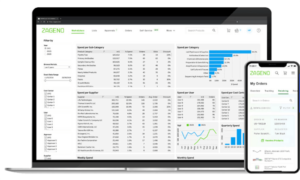How to Do Knowledge Management in the R&D Lab & How it Impacts Compliance

In the R&D lab, there is a massive amount of information that needs to be shared. It needs to be accurate, timely, and comprehensive. When you have lab team members who may work different shifts, from different locations, and on different experiments and projects, the need for an organized system is even more important.
Here’s a run down on knowledge management in the lab and how you can use principles of file and document organization to improve compliance, safety, and research outcomes.
What is Knowledge Management?
Knowledge management is the process of documenting and managing administrative information in the lab environment. This information includes stock details, data entries for lab supplies, marking opening and expiration dates for certain chemicals or reagents and other manual tasks that although are mundane and repetitive, play an important role in increasing a lab’s efficiency.
A thoroughly created and updated inventory helps in tracking records when needed, ensuring compliance to storage rules, monitoring lab supplies, and saving valuable time.
How to Do Knowledge Management in the Lab
Many small labs rely on expert scientists and researchers to contribute to the knowledge management process. However, research shows that human contribution to the knowledge sharing process doesn’t just make the lab more vulnerable to costly human mistakes, but also brings down the overall productivity of the lab. It’s shown that inventory upkeep consumes up to 25% of a scientist’s time. Imagine how much valuable time this costs the lab and how it impacts the overall functioning!
To ensure smooth functioning and cut losses, every lab must strive to automate the process of knowledge management using effective strategies. Here are 5 knowledge management strategies you can use to improve the functioning of your lab.
Hosting regular training to help your staff understand and be able to use inventory management systems is a long-term investment. Instead of assigning a single person the responsibility of creating and updating the inventory on a regular basis, it’s better to train every member of your staff to perform these tasks. This approach minimizes dependence on others and equips all members in managing a real-time inventory.
The training materials from the sessions like the tutorials and strategies need to be made accessible to all lab members for future reference via collaborative, cloud-based lab documentation software. This material helps lab staff to recall certain strategies taught during the training, or help other members get acquainted with the practice of inventory management.
When a new staff member joins, they can refer to the training material until the next proper training session is conducted.
Creating a detailed documentation structure for managing lab materials and frequently updating it is the key to a smooth-functioning lab. When important details like SKUs, supplier contact information, expiration dates, etc, are in order, people working in the lab can focus more on carrying out the tasks they are originally meant to perform. Real-time tracking also makes auditing easier and ensures accuracy between stock quantity and financial records.
FIFO is an important principle that helps you move or utilize your oldest stock on priority and then move on to the new stock. This is important for lab equipment that has expiration dates and needs to be utilized within a specified time frame. A well-documented knowledge management process will help you follow this principle to cut costs and maximize profits.
When it comes to lab supplies and equipment, there can be many unexpected issues that can arise at any time. You might run out of storage space, there might be a miscommunication between the supplier and the lab manager or you might run out of supply earlier than usual. A well-established knowledge management system helps labs prepare contingency plans to meet unexpected requirements without affecting lab efficiency.
. . .
Labs that replace mundane admin tasks with advanced technology and suitable digital tools successfully retain scientific talent, meet research requirements, boost productivity, and generate financial gains.







